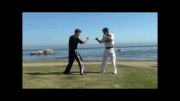drop bear
Sr. Grandmaster
You use both hands to control my head. You can't punch/elbow me at that time. You can only knee strike at me. But I have 2 free hands to catch your leg. The moment I can catch your leg, I can sweep/hook your rooting leg, the striking game will be over, the grappling game will start.
Who has advantage at that moment?
When you have double collar tie on me, I can also use my right knee strike at your right inside upper leg. My right leg can then inner hook your left standing leg and take you down.

It's an elbow. They literally are set up from hand grabs. That is how they work.


